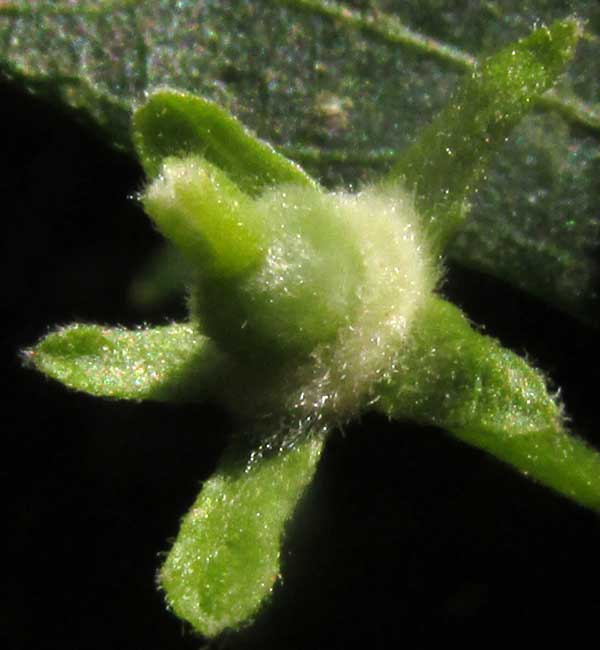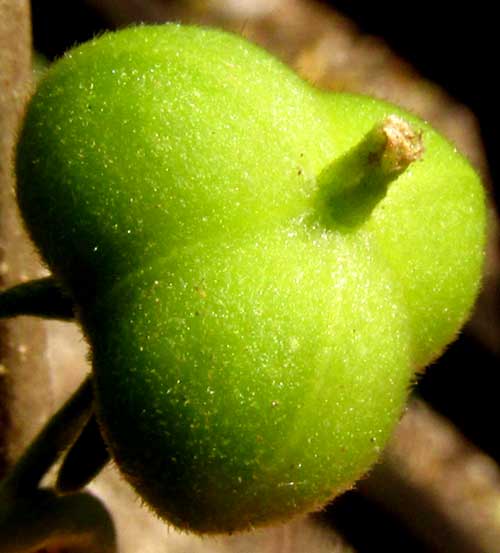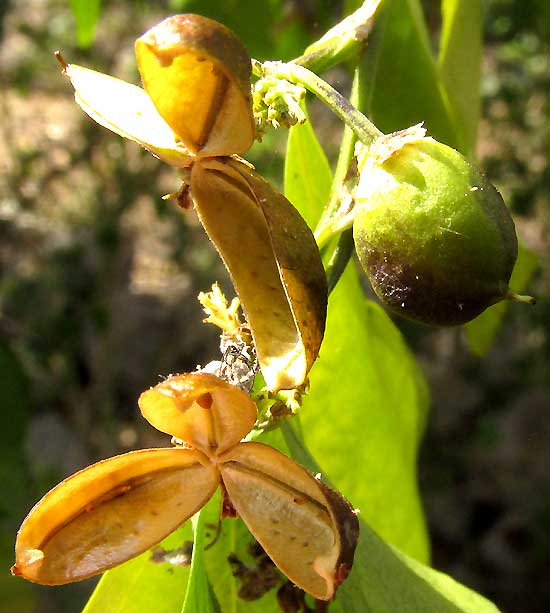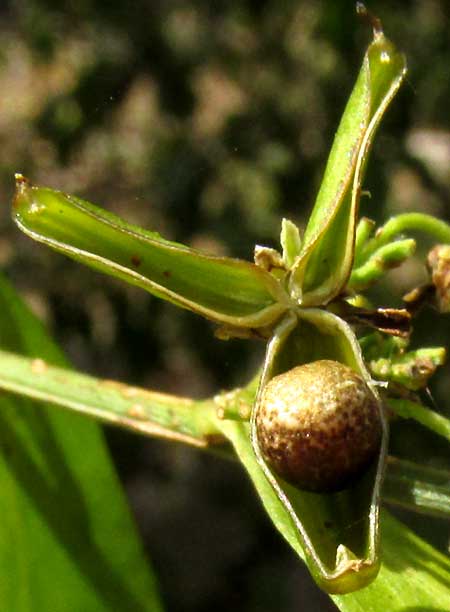Excerpts from Jim Conrad's
Naturalist Newsletter
from the December 14, 2018 Newsletter issued from Rancho Regenesis in the woods ±4kms west of Ek Balam Ruins; elevation ~40m (~130 ft), N~20.876°, W~88.170°; central Yucatán, MÉXICO
ADELIA FLOWERING
Along a cowpath through the rancho's woods a small tree about ten feet tall (3m) has been issuing clusters of small, greenish flowers, as shown below:

The flowers arise on slender pedicels issuing from where the leaves' petioles attach to the stem, in the axils, in groups of three or so, as seen below:

Up close the flowers look like fuzzy little green stars, as seen below:

The leaves' venation is noteworthy because of the unusual manner by which their secondary veins are connected by tertiary veins forming more or less rectangular cells, as seen below:

However, it's the blossom that's most informative, being so distinctive that offers hope for identification.
First of all, there's no indication at all of male stamens, so our picture shows a unisexual female flower. The spherical, vaguely three-lobed item in the blossom's center is the ovary, and it's topped by four or maybe five styles. The ovary arises from the center of a white-woolly, doughnut-shaped "disc," a structure present in only certain plant families.
The unisexual flower with a vaguely three-lobed ovary pointed toward the big Euphorbia or Spurge Family, and reminded me that we've seen a flower similar to this, an a small tree in thornforest scrub up at Río Lagartos on the Yucatan's northern coast. That tree had been identified as Adelia oaxacana, a species too obscure to bear a useful common name. On that tree we found only male flowers, but they were fuzzy and star-shaped just like our cowpath tree, as you can see on our Adelia oaxacana page at www.backyardnature.net/mexnat/adelia.htm
Two Adelia species are listed for the Yucatan, and our cowpath tree is the second one. It's ADELIA BARBINERVIS, commonly occurring in the Yucatan's disturbed habitats, and described as a component of the "regrowth ecosystems" resulting from Mayan slash-and-burn milpa/cornfield agriculture.
Adelia barbinervis is fairly well documented on the Internet, but Adelia oaxacana is not. Herbarium specimens shown on the Internet show that the leaves of Adelia oaxacana are shallowly lobed at their bases, while leaves of our present Adelia barbinervis gradually diminish toward their bases. I found Adelia oaxacana flowering in June at the same time leaves emerged after the dry season, but the present Adelia barbinervis is flowering among leaves that have been present the entire rainy season.
Adelia barbinervis is native to southern Mexico south to El Salvador. Traditionally its leaves and fruits have been steeped in hot water to prepare a tea for general body-ache, and bathing the body with the tea has been thought to heal flesh wounds.
from the January 4, 2019 Newsletter issued from Rancho Regenesis in the woods ±4kms west of Ek Balam Ruins; elevation ~40m (~130 ft), N20.876°, W88.170°; north-central Yucatán, MÉXICO
ADELIA FRUITS ALMOST RIPE
When the above flower pictures were taken, in early December, the ovary only faintly was three-lobed, a hint at the species' membership in the big Euphorbia or Spurge Family. Now those flowers are producing conspicuously hairy, three-lobed, immature fruits worth paying attention to. Below, you can see one:

Already you can see the sutures that later will split, forming an opened, three-parted capsule, from which three seeds will come. I'm looking forward to seeing whether the seeds will be ejected, just tumble out, or maybe dangle from a stringlike funiculus. One interesting feature is that already the ground below the tree is covered with hundreds of unopened, green fruits, aborted before they opened. Still, thousands of healthy-looking fruits remain on the little tree.
from the March 15, 2019 Newsletter issued from Rancho Regenesis in the woods ±4kms west of Ek Balam Ruins; elevation ~40m (~130 ft), N20.876°, W88.170°; north-central Yucatán, MÉXICO
ADELIA'S FRUITS OPENING
In our January 4th Newsletter of this year, already we were saying that the capsular fruits were almost ripe, looking ready to split open and eject their seeds. Only now are those capsules opening, as shown below:

I'm pretty sure, but not 100% so, that the capsules open explosively, ejecting their seeds some distance. One evidence of this is in the above picture's lower, left corner corner, where each capsule segment's inner face displays a curved rib. I'm betting that as the capsule dries, the rib pulls on the wall segments it's attached to, and at a certain point the tension caused by the ribs causes the capsule to split violently, catapulting the seeds.
In hardly any open capsules were seeds to be found, except in one fruit among hundreds, and it's shown below:

In that picture the two seedless walls are puckered, indicating that drying does cause contraction that could cause tension enough to split the capsule apart.